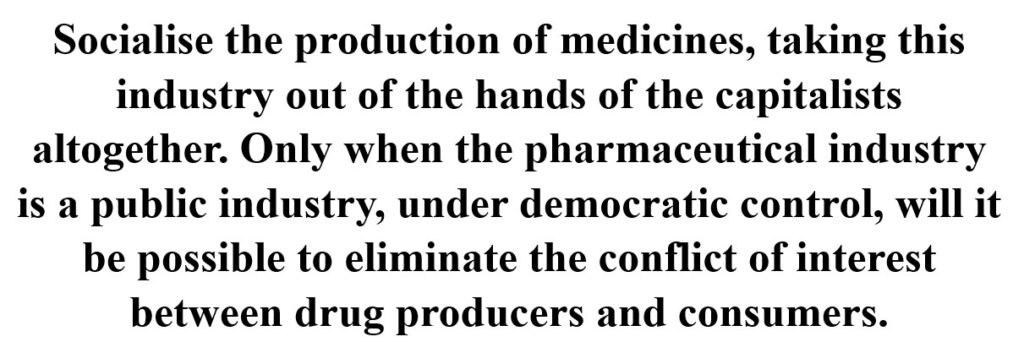By Doctor Boris Campos, Lorient, Brittany
Editorial note: in the second part of his article Doctor Boris Campos describes the power the pharmaceuticals industry holds over the French health care system. He calls for an integrated publicly-owned health care system and the nationalisation of Big Pharma
Let us now turn to the question of freedom of prescription, bearing in mind that this freedom only has real meaning when access to treatment is guaranteed for all. Its existence is therefore conditioned by that of the Social Security system, which was intended to guarantee universal access to healthcare. The defenders of freedom of prescription are, however, far from being in the front line when it comes to defending Social Security.
Freedom of prescription is understood as the independence of prescribers from non-healthcare organisations. Therapeutic considerations must take precedence over the economic aspects. This implies a struggle against managers and politicians whose sole concern is to “control public spending”. Various mechanisms have been introduced to try to control prescriptions, under the cover of public health concerns. We must fight these encroachments, which place economic objectives above the requirements of public health, and demand democratic management of Social Security.
The other interest group that seeks to influence prescribers is the pharmaceutical industry. Freedom of prescription is obviously limited by the range of molecules available. It is therefore regulated by the organisations which issue marketing authorisations, and which decide on levels of public reimbursement.
Distribution of useless or dangerous medicines
Medications that are reimbursed are supposed to have demonstrated their effectiveness. The distribution of some medications that are useless, or even dangerous, raise the question of in whose interests they are made available to prescribers. The drug market is distinguished from others by the presence of an intermediary between supply and demand, namely the prescriber, and by the predominantly public nature of the financing of demand. The money, for the most part, does not come directly from the “consumer”, but from Social Security.
As French law limits advertising to patients, marketing targets the doctor. To increase sales volume and therefore profits, a laboratory must influence the prescriber and try to manipulate “free choice” in prescribing. The doctor is therefore at the heart of the conflict between private interests (the profits of laboratories) and the general interest (the choice of the right treatment, which, incidentally, is not necessarily medicinal, at the right time).
To achieve their goals, the laboratories use a range of strategies: organisation of congresses, financing of clinical studies, medical visitors, trinkets and gifts, invitations to presentations in prestigious high-end venues, etc. On a global scale, the sums spent on these strategies are counted in billions of dollars, which is an indication of the extremely high profits at stake for the pharmaceutical industry.

Big Pharma prioritises its profits above therapeutic considerations
By seeking to promote the prescription of this or that product, the pharmaceutical industry seeks to prioritise the economic aspect – its own profitability – over therapeutic considerations. Freedom of prescription therefore does not only concern independence from public authorities. It must also concern all organisations or companies presenting a potential conflict of interest with the public interest.
Expert groups drafting recommendations for good practice must, for example, be free of any conflict of interest. Moreover, doctors should not have the right to prescribe useless or dangerous medicines. Withdrawing such useless but highly profitable medicines from the market is seen by some as an infringement of prescriptive freedom. Before freedom of prescription can be defended in its entirety, it must be freed from governmental and industrial pressures.
And for this, we consider that the best way is to socialise the production of medicines, taking this industry out of the hands of the capitalists altogether. Only when the pharmaceutical industry is a public industry, under the democratic control, will it be possible to eliminate the conflict of interest between drug producers and consumers.
Faced with the development of “medical deserts”, the response of public authorities has been to seek to influence market mechanisms. This is the meaning of installation incentives. To fill the gaps in access to healthcare, they try to attract doctors by offering them more lucrative conditions. These measures are very expensive and their effectiveness is highly questionable.

Health Authorities compete to attract doctors
Worse still, this response is based on competition between local authorities, in the context of an overall decline in state funding. Municipalities in difficulty must find the resources to be competitive, to attract doctors, offering free rent, tax exemption, and all kinds of perks. Thus, the response to a problem created by competition, the response has been to exacerbate competitiveness.
The other lever which could alleviate desertification would be to increase the number of trained doctors. This seems like an obvious option, but would not be enough, in itself, to resolve the problem. The number of doctors is distinct from that of their distribution across the country. In fact, the old problem of inequalities in distribution is highlighted by the new problem of declining healthcare provision.
In the context of market “regulation”, there may be more doctors, but the question of their unequal distribution will not be resolved. The increase in the number of doctors should therefore be coupled with state regulation that enforces an equitable distribution of the medical population. And if competition fears plethora, this would not be the case for a public service having the means to face up to its task.
For professionals, it would reduce their working time. For patients, it would facilitate access to care and reduce waiting lists. And until society judges that there are just too many doctors, there is still plenty of room for all.
For a fully integrated public healthcare system
To sum up, in place of fee-per-service payment, we stand for payment for the function of medical practitioners, employed by the state. We demand the abolition of Sector 2 (which allows for pricing over and above the levels agreed to by Social Security), and the generalisation of full third-party payment, so that the patient has nothing to pay up front.

We want to protect freedom of prescription from the influence of the industry and guaranteed free and informed access to treatment for the patient. Instead of market regulation of healthcare provision, we propose public regulation and a rational territorial network of public primary care structures. Currently, the provision of medical care is primarily a private enterprise guaranteed by public funding.
We want to resolve this contradiction by creating a fully integrated public health service, including the development, production and distribution of medicines. We have no hostile intent towards to private doctors, but categorically reject the founding principles of private medicine as a system.
The link to the first part of the article can be found here



